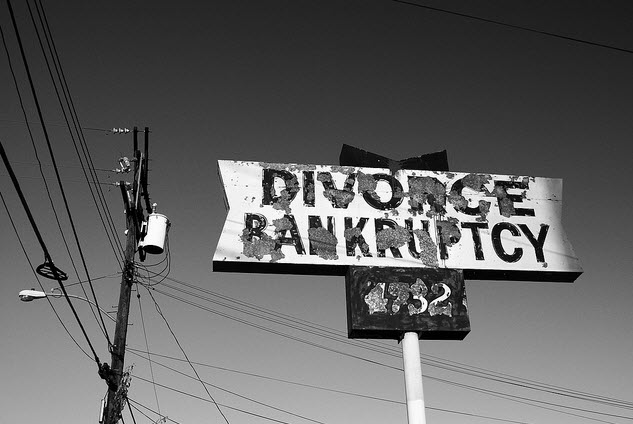 It is generally accepted that bankruptcy’s origins began in the Torah and Old Testament within the Book of Deuteronomy Chapter 15:1-2 as well as under Mosaic law. The story loosely translated states that all debts shall be forgiven at the end of every seven years. From this our founding fathers outlined bankruptcy rights and courts in our Constitution. Even today we have maintained the “end of every seven years” rule by allowing a Chapter 7 discharge to be achieved only ever eight years (eight being the end of seven).
It is generally accepted that bankruptcy’s origins began in the Torah and Old Testament within the Book of Deuteronomy Chapter 15:1-2 as well as under Mosaic law. The story loosely translated states that all debts shall be forgiven at the end of every seven years. From this our founding fathers outlined bankruptcy rights and courts in our Constitution. Even today we have maintained the “end of every seven years” rule by allowing a Chapter 7 discharge to be achieved only ever eight years (eight being the end of seven).
These holy books also say that a person who is freed from debt-bond should not be left empty handed. The idea behind this is that releasing a person from debts does no good if they must then incur new debts to survive -they need some amount of property with which to rebuild. Again, our country has followed this wisdom, this time by creating bankruptcy property exemptions. By allowing debtors to retain some property, they will be better suited to rebuild and will be less likely to become ‘slaves’ to debt again.
There are many complexities to bankruptcy that you should know before you make the life changing decision to file. If you’d like to sit down with me for an hour to see if bankruptcy is right for you, contact a Jacksonville Bankruptcy Attorney or call us at (904) 685-1200 for a free consultation.
Articles Posted in Chapter 13
Changes Proposed to Judicial Foreclosure Procedure
 As I’ve said before, there has been a steep decline in foreclosure filings, however a recent article in The Florida Bar News by Gary Blankenship, explains that despite the decrease in foreclosures last year, there appears to be an enormous backlog of foreclosures yet to come.
As I’ve said before, there has been a steep decline in foreclosure filings, however a recent article in The Florida Bar News by Gary Blankenship, explains that despite the decrease in foreclosures last year, there appears to be an enormous backlog of foreclosures yet to come.
Linda Goodner, a States Courts Administrator recently appeared before the Senate Criminal and Civil Justice Appropriations Subcommittee to discuss what changes would be needed to handle the estimated 368,000 foreclosure cases pending in courts across Florida as well as the cases that are yet to be filed. In her estimation, there will be another 380,000 cases filed by 2016 -at which point she anticipates that foreclosures will return to normal.
One proposal came from Representative Shawn Harrison who proposed that banks be given the ability to pursue non-judicial foreclosure in exchange for giving up their rights to file deficiency judgments. This is an interesting proposal.
Both Spouses Don’t Always Have to File
 Many of those considering bankruptcy wonder if they too must file bankruptcy if their spouse does. In truth, they do not. Although it’s sometimes a good idea for both spouses to file on a joint petition, it is not always necessary. For instance, a joint filing means paying only one filing fee and will allow both parties to get on with their life (there may be some special property exemptions available in this situation as well).
Many of those considering bankruptcy wonder if they too must file bankruptcy if their spouse does. In truth, they do not. Although it’s sometimes a good idea for both spouses to file on a joint petition, it is not always necessary. For instance, a joint filing means paying only one filing fee and will allow both parties to get on with their life (there may be some special property exemptions available in this situation as well).
In some circumstances, all or most of the debt will be in one spouse’s name. In that case, it may make sense to file one spouse and not the other. Any joint debts (debts that are in both names) can be discharged as to one party, but will leave the non-filing spouse solely responsible for those debts.
Once in a while, I meet a person who hasn’t spoken to or seen their spouse in years. They no longer have joint debts and are in every sense (other than legally), divorced. The courts recognize that this sometimes happens and allow married couples to file bankruptcy individually and allow them to maintain separate homestead exemptions. All that the court requires to do this is that the debtor filing bankruptcy swear that the separate households are maintained for some other reason other than to defraud the bankruptcy court.
Debtors Can Often Keep Their Cars in Bankruptcy, Motorcycles Maybe
 Although bankruptcy filers using Florida exemptions are only allowed to keep around $1,000 in vehicle equity, financed vehicles can almost always be kept through a bankruptcy case. Generally, items that are reasonably necessary for the care and support of the debtor and their dependents are exempt from seizure for the benefit of creditors. For more about exemptions, read my article on Keeping Personal Property in Bankruptcy.
Although bankruptcy filers using Florida exemptions are only allowed to keep around $1,000 in vehicle equity, financed vehicles can almost always be kept through a bankruptcy case. Generally, items that are reasonably necessary for the care and support of the debtor and their dependents are exempt from seizure for the benefit of creditors. For more about exemptions, read my article on Keeping Personal Property in Bankruptcy.
Different rules apply when the vehicle is unreasonable or has an inappropriately large amount of equity. For instance, a Maserati may be unreasonable to attempt to reaffirm in a Chapter 7. In Chapter 13 there are two mechanisms that can cause problems with keeping high value or unnecessary vehicles. The first of these is the “Feasibility Test” of the Chapter 13 plan. When you submit a payment plan in Chapter 13 the plan itself must be reasonable. If you’re making a $700 payment per month on a turbocharged super-mobile and only make $1,200 a month, your plan may be unfeasible.
The second and more likely test is the “best interest of the creditors” test. This test, more formally known as 11 U.S.C. § 1129(a)(7)(A)(ii) requires that the creditors in a Chapter 13 obtain at least as much money for their claims as they would in a Chapter 7 liquidation case. If a debtor retains a motorcycle that would have to be liquidated in a Chapter 7, the debtor must either turn the vehicle over to the Chapter 13 trustee or offer to pay the value of the motorcycle to the unsecured creditors over the life of the plan.
Creditors Barred From Collecting Past Claims Bar Date

A Notice of Filing Bankruptcy is generated in every bankruptcy case and goes out to all of the debtors various creditors. That notice has important dates on it, such as the date of the “Meeting of Creditors” and a “Deadline to File Object to Exemptions”. The notice also typically establishes the “Claims Bar Date”. The Claims bar date establishes a date by which all creditors must have filed claims in your case. If there is no claim made, then the creditors can never collect. Because many creditors don’t file claims, it is possible to pay less in a Chapter 13 than paying individual creditors through settlement negotiations. This is especially true with residential mortgages.
If you have multiple debts and would like to learn more about the claims bar date in bankruptcy, contact a Jacksonville Beach Bankruptcy Attorney or call us at (904) 685-1200 for a free consultation.
Bankruptcy and Medical Debts

There are various causes of bankruptcy, one of the most common is illness. Some studies go so far as to state that 62% of all bankruptcies are caused by medical bills. Some call this a “Medical Bankruptcy”, though there is not technically any such thing. A recent study by the American Society of Clinical Oncology found that cancer patients are almost twice as likely to file bankruptcy as are their healthy counter-parts.
Nearly all medical debt is unsecured. Unsecured debts are generally discharged in a Chapter 7 bankruptcy and in a Chapter 13 bankruptcy they are paid your disposable income for a per-determined period of time. Even cosmetic medical debt is unsecured although that may not mean you can discharge it due to bankruptcy rules regarding luxuries. Reconstructive cosmetic surgery debt is generally acceptable to discharge as it is considered reasonable and necessary. The one caveat to discharging medical debt is that you want to be as reasonably sure as possible that you are filing at the right time. You don’t want to file bankruptcy after having a knee replacement only to have the other one replaced two months later.
If you would like a free consultation to talk about your medical debt and how it can be handled in bankruptcy, contact a Jacksonville Bankruptcy Attorney or call us at (904) 685-1200.
Bankruptcy Stress Brings About Divorce?
 According to Marianne Culhane’s chapter in the collaborative book, “Broke”, 36% of those filing bankruptcy considered divorce or separation as a result of the stress. This is not at all surprising as people often cite “financial difficulties” as a reason for separating. 36% is an enormous number. Less alarming is that the number of people who actually did divorce after bankruptcy was 18%. Still, that’s just short of one out of five couples.
According to Marianne Culhane’s chapter in the collaborative book, “Broke”, 36% of those filing bankruptcy considered divorce or separation as a result of the stress. This is not at all surprising as people often cite “financial difficulties” as a reason for separating. 36% is an enormous number. Less alarming is that the number of people who actually did divorce after bankruptcy was 18%. Still, that’s just short of one out of five couples.
Florida has become well known in the divorce world, being home to eleven of the top fifty cities with the highest divorce rates in the United States. If you live in Panama City, there is a 16% chance that you’ve been divorced before -the highest rate in the country.
However, Florida also filed the second highest number of bankruptcies in the United States in 2010. While this doesn’t prove that the bankruptcies caused the divorces, I think it’s safe to assume that one has some effect on the other.
Craming-Down Negative Equity in Vehicles Goes Further
 When you finance a car, it’s accompanied by a note and there’s a monthly payment. The note gives the seller security, as they now have recourse if you don’t pay -they can repossess the vehicle. This system is good for the seller because their money is backed by an asset instead of backed by your credit score. You can damage a credit score, but you can’t repossess a credit score and sell it to someone else.
When you finance a car, it’s accompanied by a note and there’s a monthly payment. The note gives the seller security, as they now have recourse if you don’t pay -they can repossess the vehicle. This system is good for the seller because their money is backed by an asset instead of backed by your credit score. You can damage a credit score, but you can’t repossess a credit score and sell it to someone else.
Ideally, the payment on the vehicle is based on the predicted future value of the car. If the car costs $10,000 today and will only be worth $2,000 in eight years, your payments over the eight years need to add up to $8,000 to keep the value balanced to the payments (I left interest out to make it less complicated). However, in some instances where the buyer’s credit is good the seller can offer the vehicle at a lower monthly payment despite knowing that the vehicle will be worth less than is owed on it. This is called negative equity. Eventually, that vehicle dies and the buyer is forced to purchase another car, still owing on the first. Instead of having a buyer who is unable to make two car payments, the new financing company offers to pay off the first car and roll the debt from it over into the new car’s note. Over time this vehicle gets more and more underwater and eventually the debtor is forced to file bankruptcy.
A “Cram-Down” occurs when a debtor asks the court to determine the value of their vehicle and to make this value the secured amount of the debt. i.e. if the debtor owes $10,000 on a vehicle, but it is now only worth $2,000, the court can lower the secured amount owed to $2,000. The remaining $8,000 becomes unsecured. This can be done in both a Chapter 7 or a Chapter 13 bankruptcy. However in a Chapter 7 the $2,000 has to be paid immediately, so it is less practical than in Chapter 13 where the debtor has several years over which to make payment.
JPMorgan Chase Bank sued for more than $10,000,000
 Chase has been accused of filing false claims in bankruptcy cases, with allegations that their attorneys have gone so far as to Photoshop documents to increase the ease of obtaining relief from the automatic stay. Those attorneys are purportedly paid from $600 to $1,000 for every relief from stay they obtain. These fees are then added to the bank’s claim to be paid by the debtor.
Chase has been accused of filing false claims in bankruptcy cases, with allegations that their attorneys have gone so far as to Photoshop documents to increase the ease of obtaining relief from the automatic stay. Those attorneys are purportedly paid from $600 to $1,000 for every relief from stay they obtain. These fees are then added to the bank’s claim to be paid by the debtor.
It’s not just Chase’s lawyers that are alleged to be doing funny business. The institution is also alleged to have falsely collected on Deeds of Trust that they are not the true party of interest on. The declarations of ownership and endorsements come from employees who are purported to be known, “robo-signers”. A copy of the Complaint can be found here.
For Richer and for Poorer
 In 2008 John Ignatius Quinn was declared the richest person in Ireland with holdings worth approximately $6 billion dollars. Now, three years later, he finds himself facing bankruptcy.
In 2008 John Ignatius Quinn was declared the richest person in Ireland with holdings worth approximately $6 billion dollars. Now, three years later, he finds himself facing bankruptcy.
Quinn, the son of a small farmer began earning his vast wealth through the Gaelic Athletic Association. From there he went into the concrete business, then hotels, and so on. But Quinn, like many of us in the Western World, is facing severe financial problems.
Unfortunately for Quinn, bankruptcy in Northern Ireland differs from bankruptcy in the Irish Republic. Filing in one country will allow him to resume business in a year, the other can take up to twelve years. Since this will have a profound effect on one of his largest creditors, Irish Bank Resolution Corp., they are fighting viciously to get have the court move his bankruptcy to the twelve year forum. This is similar to our Chapter 7 and Chapter 13 bankruptcies, in that a creditor (or trustee) can attempt to have a case dismissed or converted if it is shown to be improper for the debtor. This is often done only if financially beneficial for the creditor.
 Jacksonville Bankruptcy Lawyer Blog
Jacksonville Bankruptcy Lawyer Blog


